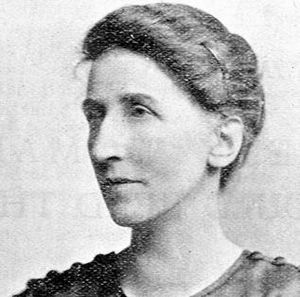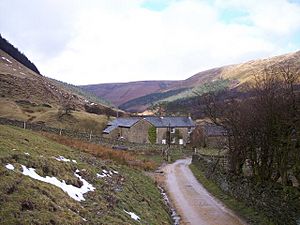Hannah Mitchell facts for kids
Quick facts for kids
Hannah Mitchell
|
|
|---|---|
 |
|
| Born | 11 February 1872 Hope Woodlands, England
|
| Died | 22 October 1956 (aged 84) Manchester, England
|
| Nationality | English |
| Occupation | Dressmaker |
| Known for | Suffragette, councillor |
| Political party | Independent Labour Party |
| Spouse(s) | Gibbon Mitchell |
| Children | 1 |
Hannah Mitchell (born 11 February 1872 – died 22 October 1956) was an important English woman who fought for women's rights and for a fairer society. She was a suffragette, meaning she worked hard to get women the right to vote. She was also a socialist, which means she believed that society should be more equal for everyone, especially working-class people.
Hannah grew up in a poor farming family in Derbyshire. She left home when she was young to work as a dressmaker in Bolton. There, she became very interested in the socialist movement. She spent many years working with groups that supported socialism, women's right to vote, and pacifism (the belief that all war is wrong). After World War I, she was elected to the Manchester City Council and became a magistrate (a type of judge). Later, she even worked for Keir Hardie, a leader of the Labour Party.
Contents
Hannah Mitchell's Life Story
Growing Up: Her Early Years
Hannah Webster was born on 11 February 1872. Her parents, Benjamin and Ann Webster, lived in a farmhouse near Alport Castles in Hope Woodlands, Derbyshire. She was the fourth of six children in her farming family.
Hannah's mother could be difficult, especially with her younger children. Hannah was not allowed to go to school, but her kind father taught her how to read. She had to stay home and do chores with her mother, which she did not enjoy. She also felt it was unfair that she had to look after her father and brothers.
Even when she was young, Hannah noticed that girls and boys were treated differently at home. She saw that many girls around her married young to avoid having children outside of marriage. Hannah wanted a different life for herself. She later wrote that her mother sometimes made the children sleep in the barn.
When Hannah was 13, she became an apprentice dressmaker. This helped her poor family earn a little more money. She worked for an older dressmaker named Miss Brown in Glossop. Hannah wrote that Miss Brown was much kinder than her mother and showed her that work could be enjoyable.
At 14, after an argument with her mother, Hannah left home. She went to live with her brother William and his family in Glossop. When she was 19, she moved to Bolton, Lancashire. There, she found work as a dressmaker, earning ten shillings a week, and also worked in domestic service (as a house helper).
Marriage and Joining the Socialist Movement
In Bolton, Hannah wanted to learn more and hoped to become a teacher. She worked for a schoolmaster who let her borrow his books. She soon became involved in the socialist movement. This movement aimed to make society fairer for working people.
Hannah spoke out for better working conditions, like shorter hours and a paid half-day off each week for shop workers. She noted that women in the clothing industry faced low pay, bad conditions, and were often forced to be silent.
She also went to meetings at The Labour Church, which combined religious ideas with socialist ones. She was greatly inspired by The Clarion, a newspaper by Robert Blatchford. She also heard Katharine Glasier, a famous socialist speaker, give a talk.
Hannah met Gibbon Mitchell, a tailor, where she was staying. They both wanted to have their own home. They married in 1895 in Hayfield. In 1896, their son, Frank Gibbon Mitchell, was born. Hannah decided not to have more children because of the difficult birth and the challenges of poverty. They also cared for an orphaned niece.
Hannah soon felt that marriage was not as equal as she had hoped. Her husband had agreed to share household chores, but in reality, she did most of them. She continued to work as a dressmaker to help with money. Like other women in the socialist movement, Hannah found it hard to convince men that women's rights were just as important.
The couple moved to Newhall, where socialists had built a meeting hall. Speakers often stayed with the Mitchells. In 1900, they moved to Ashton-under-Lyne, near Manchester. Hannah began speaking publicly for the Independent Labour Party (ILP). In 1904, the party chose her to be a Poor Law Guardian for their town. This meant she helped manage aid for poor people.
Fighting for Women's Right to Vote
Hannah then joined the Women's Social and Political Union (WSPU). This group was led by Emmeline Pankhurst and her daughter Christabel Pankhurst. Hannah worked part-time as an organizer for them. She believed in true equality for all voters, not just for some women.
She heard Annie Kenney speak and noticed that most people wanted all men to vote first, making women wait even longer. Hannah traveled around the country, giving speeches for women's right to vote. She campaigned in by-elections and was good at handling people who disagreed with her.
In 1905, Hannah was with Emmeline Pankhurst and other suffragettes when Christabel Pankhurst was released from prison. Christabel had been jailed for spitting at a policeman as part of their protests. Hannah was also among 150 women who tried to enter the House of Commons in October 1905. Only 20, including Hannah, were allowed in.
Hannah and Louie Cullen had hidden a "Votes for Women" banner in their clothes. When they were told the Prime Minister would not support a women's suffrage bill, Mary Gawthorpe stood on a chair to speak. Police pulled her down, and the banners were raised but torn to shreds by police. Hannah was shocked to see how roughly Mrs. Pankhurst was treated. Members of Parliament watched and laughed.
Hannah continued campaigning, including in Huddersfield, where many women joined their cause. She also helped start a WSPU branch in Liverpool. In 1907, Hannah became very ill from overwork and not eating enough. While she was recovering, Charlotte Despard, another suffragette leader, visited her and gave her money for food. Hannah felt sad that the Pankhursts did not contact her during this time. In 1908, she left the WSPU and joined Despard's new group, the Women's Freedom League.
During the First World War, Hannah supported the pacifist movement, which believed in peace and opposed war. She volunteered for groups like the ILP No Conscription Fellowship and the Women's International League for Peace and Freedom. In 1918, she started working with the ILP again. In 1924, they nominated her for the Manchester City Council. She was elected and served until 1935. In 1926, she became a magistrate (a local judge) and served for 20 years.
Later Life and Legacy
On 9 May 1939, Hannah helped organize a meeting of 40 former suffragettes in Manchester. Towards the end of the Second World War, she started writing her autobiography, which was published after her death. After the war, she wrote for newspapers like The Northern Voice and Manchester City News.
In her last years, Hannah lived in Newton Heath. There is a blue plaque on her house at 18 Ingham Street, Newton Heath. This plaque honors her and marks the place where she wrote her autobiography, "The Hard Way Up."
Hannah Mitchell passed away on 22 October 1956 in Manchester. Her autobiography, The Hard Way Up, the Autobiography of Hannah Mitchell, Suffragette and Rebel, was published in 1968 by her grandson. Another blue plaque honors her on the house in Ashton-under-Lyne where she lived with her family from 1900 to 1910.
The Hannah Mitchell Foundation
In 2012, the Hannah Mitchell Foundation was created. This group works to develop local government in the North of England. They chose Hannah's name to remember her as a great northern socialist, feminist, and co-operator. She was proud of her working-class background and had a vision for both culture and politics.
See also
 In Spanish: Hannah Mitchell para niños
In Spanish: Hannah Mitchell para niños


